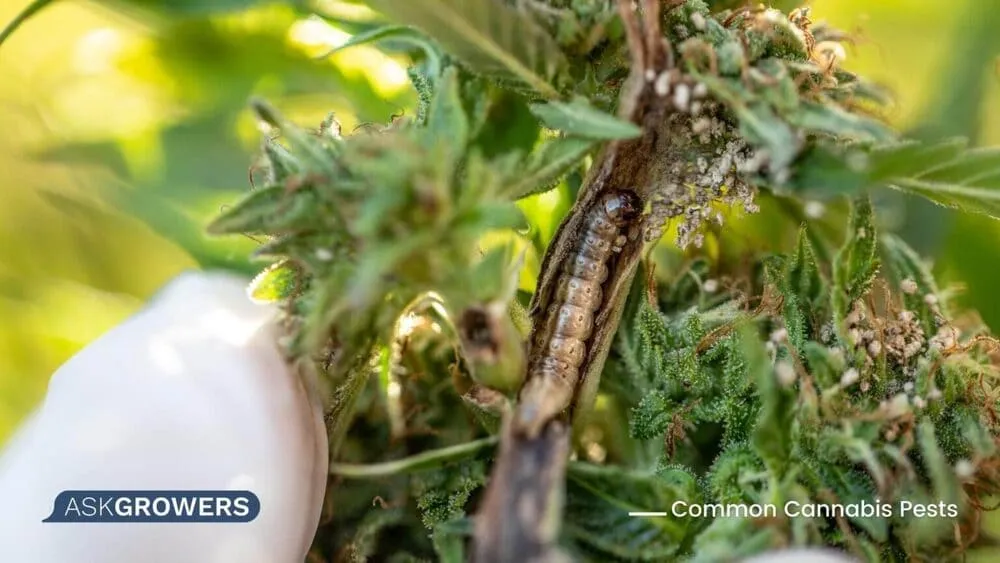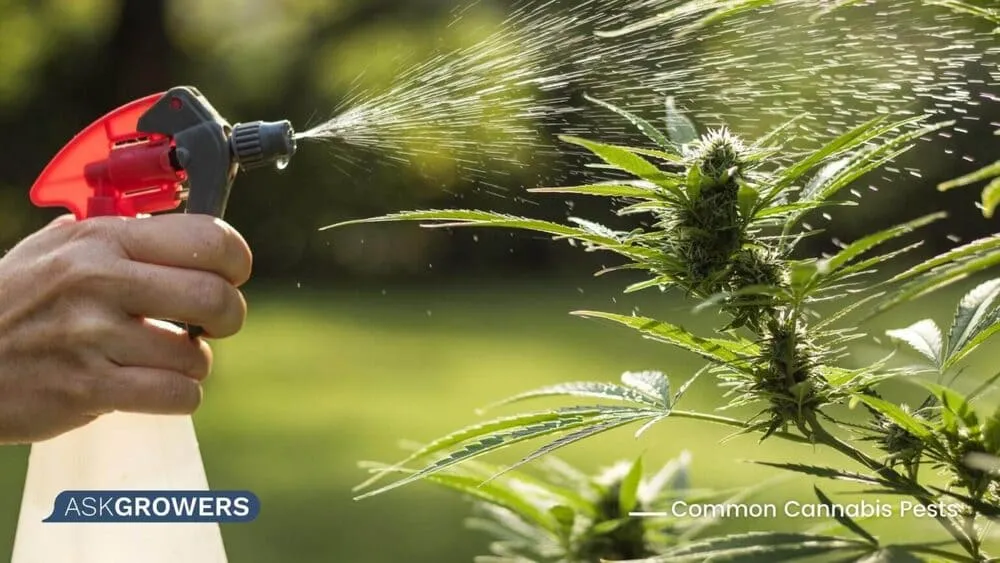Growing marijuana is a more complicated undertaking than breeding an average houseplant, and its growers may encounter some common problems. Various pests and insects are likely to pop out, even with plants grown indoors. Pests are pretty skilled at hiding among the plants and multiplying. Before making an informed decision about solving a problem, it is necessary to identify the plant suppressor. Learn more about determining the pest signs and how to treat them quickly without damaging your plants.
Common Weed Pests
What are the main pests of marijuana? When it comes to identifying pests, they can be classified into two main categories:
- Sucking insects that pull nutrients out of the plant;
- Chewing insects that eat cannabis leaves and other plant parts.
Gardeners should watch out for holes in cannabis leaves, discoloration signs, and webbing to identify the issue and treat it promptly. Learning the essential appearances of the typical pest damage will allow you to be informed and make a proper decision.

This list covers typical pests that can affect cannabis crops and the signs they leave:
- Aphids. Cannabis is a frequent host of this insect, as stated by the Journal of the Integrated Pest Management. These bugs live around the plant stems and on the back of the leaves. They feed on the leaf sap, so dry yellow leaves are signs of their invasion. They are fast at reproducing and forming colonies. Also, aphids produce an amber substance to attract other insects.
- Ants. They are one of the common cannabis root pests. These insects are known to damage the root system, negatively affecting the yields. As a rule, their infestation precedes an aphid invasion. They protect the aphid’s colony, allowing it to multiply.
- Red spider mites. These insects cover leaves with yellow/black spots and create spider webs. They suck the sap from plants and lay eggs on the back of the leaves.
- White spider mites. They alter plant growth by forcing leaves to curl. These symptoms can mimic herbicide damage. To detect their eggs, look at the back of the leaves.
- Whiteflies. These are yellow-white insects that are constantly flying around the plant. They lay eggs on the back of the leaves and feed off the plant sap. Whiteflies can be virus carriers that cause mold.
- Thrips. These tiny yellow insects are hard to detect. They leave white and yellow spots on the top of the leaves, making them brittle.
- Leaf miners. These larvae live inside the leaf tissue, making white wavy trails. In these tunnels, they feed and lay eggs.
- Fungus gnats. They can emerge from the soil containing compost made of wood chips. Also, they appear in excessively humid substrate. Its larvae attack plant roots and stems, making holes in them. To beat this plague, you should get rid of an adult insect and its eggs.
- Worms and caterpillars. These insects bite leaves and leave black feces on them that can cause leaf rotting. They feed at a fast rate to form a chrysalis. As they reproduce fast, they can eat plenty of the yield. Translucent or yellow eggs and tiny teeth marks on the leaves also manifest their invasion.
- Grasshoppers and crickets. These outdoor insects can be easily identified by the noisy sounds they produce. They eat weed leaves, leaving bite marks.
- Snails and slugs. These pests are a real threat to marijuana crops. They eat foliage, leaving a slimy mucous-like trace on the leaves. They are pretty large and easy to identify.
- Moles and gophers. These rodents can be a real underground menace to cannabis gardens. They are hard to detect unless cultivators notice their earth holes.

How to Get Rid of Pests on Weed Plants
Of course, the best way is to take precautions that won’t allow any pests to invade your cannabis harvest; however, even caught in time, unwanted guests can be dealt with. This list shows the treatment methods that will allow you to get rid of the most common cannabis pests:
| Aphids | They can be removed and crushed manually. The damaged weed leaves have to be cut off. Attract aphids’ natural enemies to feed on them, for example, ladybugs and wasps. |
| Ants | For farmers who have a small cultivation area, cinnamon will be helpful. It works as a repellent that kills insects. Sprinkle it on the soil where ants are nesting. As natural enemies of ants, you can also encourage frogs to come to your growth site. Finally, you can grease the cannabis stems or place the potted plants in a water moat. |
| Red spider mites | Since they thrive in hot and dry areas, maintain your growth environment with a humidity of 55-60% and ensure good ventilation. Set the air temperature below 77°F (25°C). The spotted damaged leaves treat by spraying with a mixture of water and alcohol. Potassium soap can also help. |
| White spider mites | Use selected miticides to get rid of these pests. |
| Whiteflies | These insects are tough to get rid of. Think of planting repellent plants like basil near your cannabis crops. Spray your weed with neem oil or potassium soap. |
| Thrips | Before the flowering period starts, spray the plant leaves with neem oil or potassium soap. |
| Leaf miners | To protect plants from a possible invasion, place adhesive strips around them. To deal with the larvae, remove the infected leaves manually and treat the plants with insecticides that can be toxic. |
| Fungus gnats | Don’t overwater plants to prevent an invasion by these insects. Remove all dead plant material. If the infestation is significant, apply chemical measures to reduce the population. |
| Worms/caterpillars | These insects can easily be detected on the plant and removed. Farmers can apply garlic or pepper insecticide or introduce spined soldier bugs or wasps to the weed plantation. |
| Grasshoppers/crickets | Use insecticidal soap and other pest control products. Neem oil will also be helpful. |
| Snails/slugs | These pests are easy to spot and can be removed manually. Note that they are active at night hours. You can build a barrier around the crop and place baits for them by mixing beer and jam. |
| Moles/gophers | Spray the garden soil with water mixed with garlic and castor oil. It will make the moles migrate. Also, you can set traps or just get a cat. |

To identify pests, you can refer to simple scouting methods. Use pheromone traps or yellow sticky cards, placing them randomly around the crop. These traps will attract the adult male insects and capture them in a sticky substance.
How to Control Pests in Marijuana
Prevention is better than cure, so these tips will help you avoid this problem or at least detect an unwelcome pest in time:
- Monitor your plants regularly using a magnifying glass and check the leaves’ undersides.
- Avoid using plant cuttings as a possible source of pest problems and opt for growing practices from a seed.
- Clean your grow room regularly.
- Use new substrate for your plants.
- Keep all tools disinfected and use latex gloves for handling plants.
- Add UVB supplemental light to your growth site because it can affect pests.
- Don’t leave your potted indoor plants outside in the sun for an afternoon because it is a way to introduce insects to your growth room.
- Once detected, identify the pest correctly or contact a state entomologist for assistance.
- Use natural predators of the pests for your outdoor plants because it can control pest populations up to 100%, as proven by research conducted by Greek scientists.
- Remove damaged leaves and don’t keep this waste in the growth plantation.
- In most cases, a soapy detergent sprayed on the plants can help cope with plant-born insects.
The earlier you notice the pest invasion on your crop, the easier it is to treat using chemical-free pest management methods.
Conclusion
These are the most common problems growers can face with their cannabis crops. Ensure that the humidity and temperature levels in your cultivation site are correct and don’t attract any pests to your garden. Use preventive compounds before the flowering period because chemical products like pesticides can only be used during the vegetative phase. The strategies recommended above can be successfully implemented to minimize the risks of pest invasion and cope with detected plant enemies.

